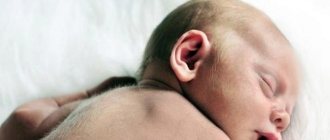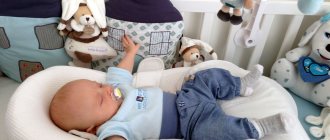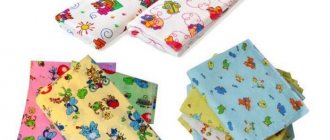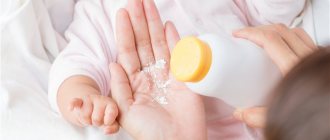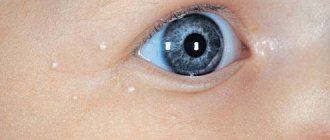Physiological features of newborn skin
The skin of babies is not much different from the skin of an adult. It also consists of the dermis and epidermis, which in turn is divided into five more layers. However, children's skin has some characteristics:
• due to the fragile connection between the epidermis and the dermis, it is much more susceptible to infectious processes, signs of which are blisters and blisters;
• in the first days after birth it has a neutral pH, which changes to acidic by 2-3 months;
• due to the immature nervous system, the sweat and sebaceous glands of the skin do not work actively, so during bathing it quickly becomes wrinkled;
• the skin's weak resistance to microbes is explained by the low bactericidal properties of the secretion secreted by its glands;
• the skin contains a large volume of water and many permeable vessels, which explains the low resistance to skin allergic reactions.
Despite this, the skin of young children manages to cope with protective, excretory, thermoregulatory and other functions. In the future, with proper care and normal physiological development, her abilities increase many times over.
Nail care
For manicure and pedicure, you will need children's scissors with rounded ends or special tweezers. It is better to put on beauty when the baby is sleeping. There is no need to think about the shape of your nails - only oval, no squares or triangles (otherwise scratches cannot be avoided). Up to six months, you should cut your nails every 3-5 days. After the procedure, it is better to wear scratch mittens.

Personal hygiene of a child is a whole science. You need to comprehend it every day and treat it with full responsibility and remember that “cleanliness is the key to health.”
Baby skin problems
Due to physiological characteristics, infant skin is less resistant to certain diseases. In order not to worry about the baby’s well-being, parents should properly care for her, paying attention not only to the umbilical wound, but also to other parts of the body. In the absence of proper skin care for a newborn baby, the following processes develop:
1. Crusts on the head
. They are dense scaly growths localized in the scalp, ears, eyelids, nose and even groin. The reason for their appearance is excessive secretion of sebum.
2. Prickly heat
. A small, non-purulent rash is localized in skin folds or areas of greatest friction. It may be accompanied by itching, which does not affect the general condition of the child.
3. Diaper rash
. Discomfort occurs behind the ears and in skin folds due to friction and contact with moisture. In mild forms, it does not affect overall well-being, but without proper care it provokes ulcers, pustules, itching and malaise.
4. Hives
. An allergic skin reaction, accompanied by swelling, redness and blisters located throughout the body. They are eliminated with the help of antihistamines.
5. Acne
. Acne is caused by hormonal changes, which are influenced by excess corticosteroids and testosterone in the mother's body. It does not require treatment and goes away within two weeks.
Caring for newborn folds. What and how to do?
Good day, dear reader! Today we will talk about what care for a newborn’s folds is considered correct, what products are best suited for a baby. This knowledge will help you avoid daily mistakes and prevent painful diaper rash and irritation in your child.
The best products for treating baby skin folds
The skin of a newborn baby contains practically no fatty lubricant, which protects it from chafing and irritation. The delicate layer of the epidermis reacts to contact with water, laundry detergents, and is easily irritated by contact with formula or soap with fragrances. Therefore, in the first months after birth, it is necessary to carefully monitor the skin.
With insufficient care, fatty grease accumulates in the folds, exfoliated epithelium rolls off, and particles of feces or urine remain after removing the diaper. This causes severe irritation, redness and rashes. The baby experiences unpleasant sensations, is capricious and does not sleep well. Washing with soap and water is often not enough: the use of moisturizers and emollients is required.
Daily care for the folds of a newborn can be carried out using special lotions and compositions:
- Baby cream . To treat the skin of a newborn, you can use only special products designed taking into account the pH level. They contain vitamin and herbal supplements and safe flavors. When rashes appear, treatment series (Bepanten, Sudocrem) are recommended.
- Cosmetic oils . All well-known brands offer plant-based formulations. They have added herbal extracts, vitamins A and E, chamomile or aloe extracts (Johnson Baby, Weleda, Mustela).
- Vegetable oil without additives . The old “grandmother’s” method of treating skin folds in a newborn remains relevant. For care, high-quality olive or sunflower oil is used. It should first be boiled in a water bath and used to moisturize the skin after bathing.
- Decoctions of chamomile or string. Plants are natural antiseptics, so they relieve irritation, itching, and discomfort after bathing or wearing a diaper.
- Powder. Light powder with the addition of talc should be used carefully. It is intended for drying skin areas in the groin area or armpits. If treated too frequently, dryness and flaking of the epidermis and inflammation easily occur.
To treat the skin of a newborn, you can use only special products designed taking into account the pH level. They contain vitamin and herbal supplements and safe flavors.
For daily care of your baby's folds, you will need soap. Pediatricians do not recommend using conventional cosmetics for adults: they often contain aggressive ingredients that additionally dry out the epidermis. It is necessary to use only high-quality series intended for children aged 0+.
In the first weeks, the skin of a newborn is practically devoid of fatty lubricant, so irritation begins even from a cotton vest or a high-quality diaper.
A hard washcloth can worsen the condition and cause pain.
When bathing or hygienically washing, it is better to use a terry mitten, which gently cleanses contaminated areas, pleasantly strokes and massages. You can use a piece of rag or towel.
How to properly care for folds in a newborn?
Caring for folds on a newborn’s body should be done daily. This is a simple procedure that, with the right approach, becomes a pleasant ritual for the baby and parents:
- The newborn should be bathed in warm water, and all folds should be carefully washed with your hand or a soft washcloth. It is better to foam a little soap, do not apply undiluted to the skin.
- When treating the skin, all movements should be stroking. The folds should be carefully opened with your fingers, removing dirt and sebum.
- After bathing, the baby must be rinsed with clean water. If rashes or irritation are observed, you can add a weak decoction of string, calendula or chamomile.
- Before treating the folds, you can leave the newborn for a few minutes without a towel. Such air baths are beneficial for the immune system and reduce the risk of dermatitis. But the procedure is carried out only in a warm room.
- Each fold should be opened slightly and carefully lubricated with cosmetic oil or baby cream. For care, it is better to purchase special cotton balls made of sterile material: they do not leave lint or pieces of cotton wool.
What to use for daily care of a newborn’s folds should be selected individually. In the first weeks, the treatment should be more intense, so you have to moisturize and nourish the skin in the groin area 2-4 times a day.
It is necessary to carefully monitor the reaction to the cosmetic product: if redness or rash appears, it is better to cancel it and show the baby to a pediatrician.
When caring for folds in an infant, it is important not to overdo it. With frequent application of a rich cream or oil, the epidermis does not have time to absorb the components, so a dense film remains. The skin stops “breathing” and painful diaper rash occurs.
Why do newborns have skin problems?
After birth, there are many folds on the baby’s body. These are natural folds of the skin, which gradually straighten out as they grow. Milk often flows into them after regurgitation, leaving traces of feces. Often, irritation begins when wearing wet diapers for a long time, due to lack of air circulation.
The greatest attention should be paid to the area on the neck, behind the ears, armpits and inguinal folds. The pellets can irritate the spaces between the fingers and the creases of the child's elbows.
The greatest attention should be paid to the area on the neck, behind the ears, armpits and inguinal folds. The pellets can irritate the spaces between the fingers and the creases of the child's elbows.
Diaper dermatitis or diaper rash often bothers the baby and complicates its care. The main causes of redness and rash:
- overheating when wrapped;
- poor quality diaper materials;
- fragrances in laundry detergents;
- liquid feces;
- use of clothing made of synthetic fabric.
Among the most common skin problems in newborns are the following complications:
- Diaper rash due to urine, feces, or liquid getting into the folds after bathing. The red areas are itchy and painful, and there may be small cracks and wounds.
- Heat rash . Appears in the form of a small rash without pus, which is concentrated only on areas of the skin that overheat (back, neck, buttocks).
- Pyoderma . The cause of the disease is the activity of streptococcal bacteria, Staphylococcus aureus. It often occurs when immunity declines, due to poor care of the newborn’s skin, and requires treatment under the supervision of a doctor.
- Allergic dermatitis . The problem is increasingly being diagnosed in children in the first year of life. The reason is the use of cosmetics with added dyes, flavors or fragrances.
Many skin problems look similar and have the same symptoms. Therefore, if a rash or redness appears in the folds, it is better to consult a doctor.
Today we looked at how to properly care for the folds of a newborn baby and listed the basic products for treating the skin. To reduce irritation, you need to leave your baby without a diaper more often and buy clothes made from natural cotton. What oils or folk recipes have you used for your baby’s hygiene?
Source: https://KinderBoo.ru/uhod-za-skladkami-novorozhdennogo/
Newborn skin care rules
As with adults, newborn skin care has its own characteristics. To keep her healthy, it is recommended:
• ensure that the skin does not come into contact with urine and feces for a long time;
• put on the child clothes made from natural materials with a minimum of seams;
• ensure that the child is not exposed to the sun for long periods of time;
• use children's cosmetics without preservatives, dyes and flavors;
• practice air baths so that the child’s skin can “breathe” normally;
• put on a diaper 15-20 minutes after water procedures;
• support breastfeeding.
By following the basic rules of caring for your baby's skin, you can enhance all its functions and maintain that delightful feeling of a gentle touch, comparable to touching silk or flower petals.
How to properly prepare chamomile infusion
Chamomile infusion is brewed in two types, depending on the form of release.
- Filter bags. 2 filter bags are placed in a glass or enamel container, pour 100 ml of boiling water, cover with a lid and leave for 15-20 minutes. After this, the filter bag is squeezed out, and the finished infusion is brought to 200 ml with boiled water.
- Chamomile in bulk. 1-2 tablespoons are poured into a glass or enamel bowl, pour 100 ml of boiling water, then placed in another enamel bowl and infused in a water bath, bringing to a boil over low heat for 15 minutes. When the broth is ready, it needs to be filtered and diluted to a volume of 200 ml with boiled water.
Each age has its own dosage of the decoction. Infants can drink 1-2 teaspoons of chamomile infusion, but not more than 2-3 times a day. Keep the finished broth in a cool place for no more than a day.
Maximum essential oil yield occurs during full development. It has a very pleasant spicy smell and somewhat bitter taste. The best quality of dried chamomile is characterized by the fact that they contain only heads free of stems and leaves, without broken tubular and reed flowers and flower beds without baldness. The sages should also not be present, and the flowers should have the shortest stopwatch. Dried chamomile flowers have a characteristic aromatic aroma and slightly bitter taste. Store them in a dry place, protected from light and moisture.
Tea: used in flatulence, intestinal colic and disorders, gastric disorders and colic, colds, bronchial catarrh, cough, insomnia, epididymitis, shortness of breath, dysmenorrhea, uterine cramps, disorders or amenorrhea. Blood vessels, gastrointestinal infections, diarrhea, urinary tract infections.

